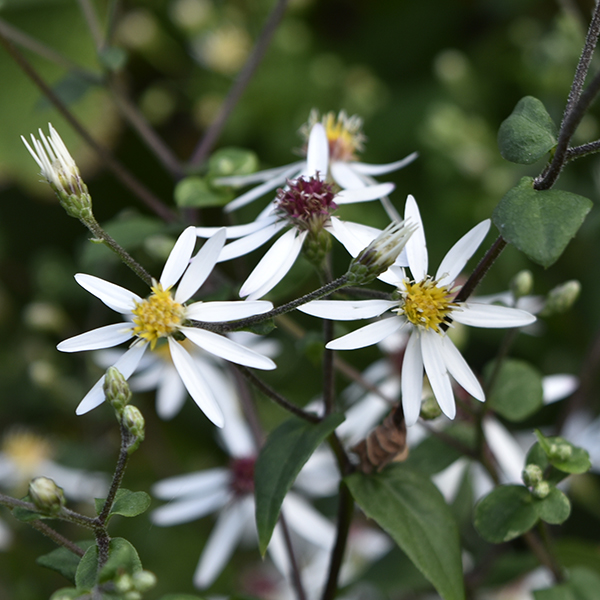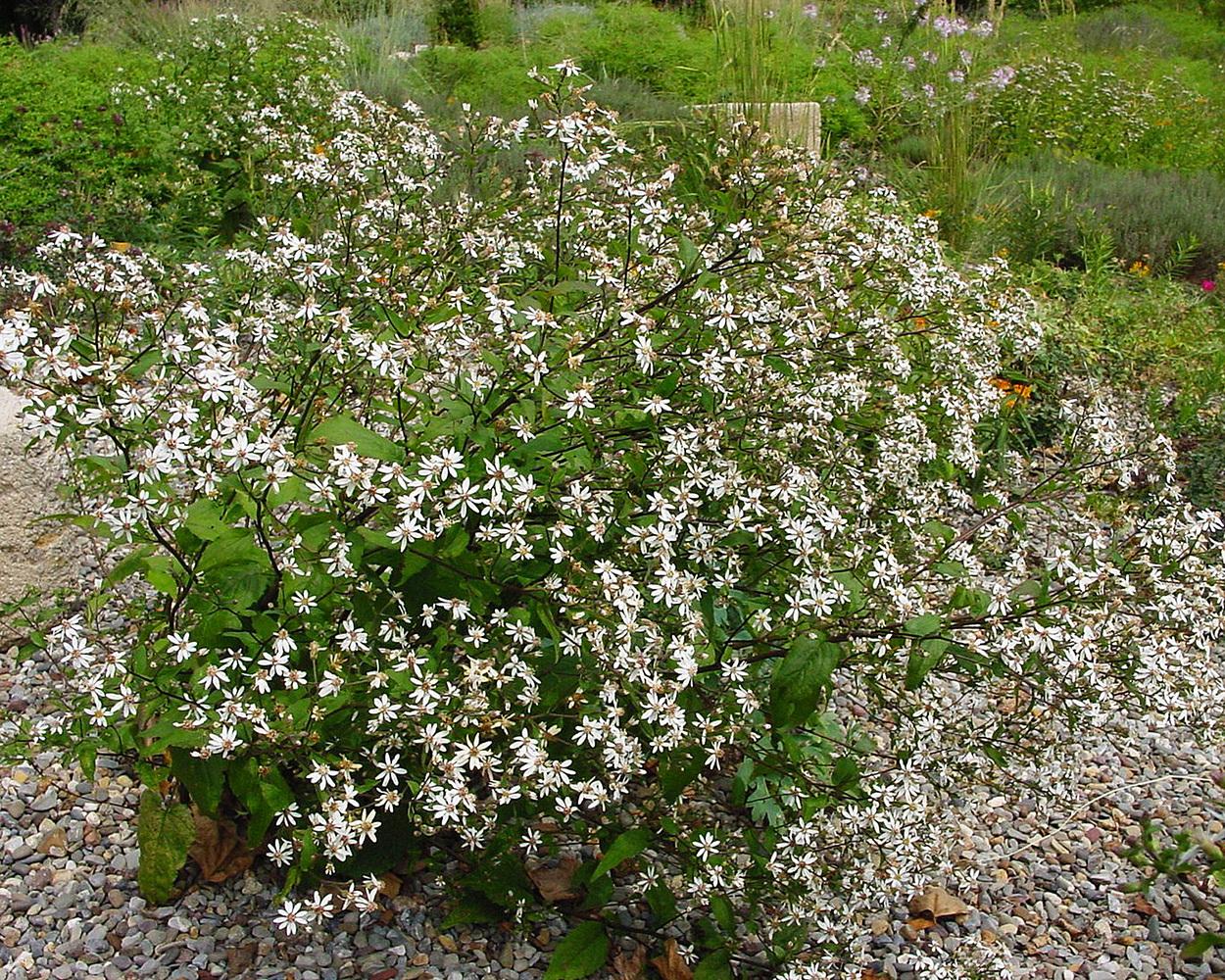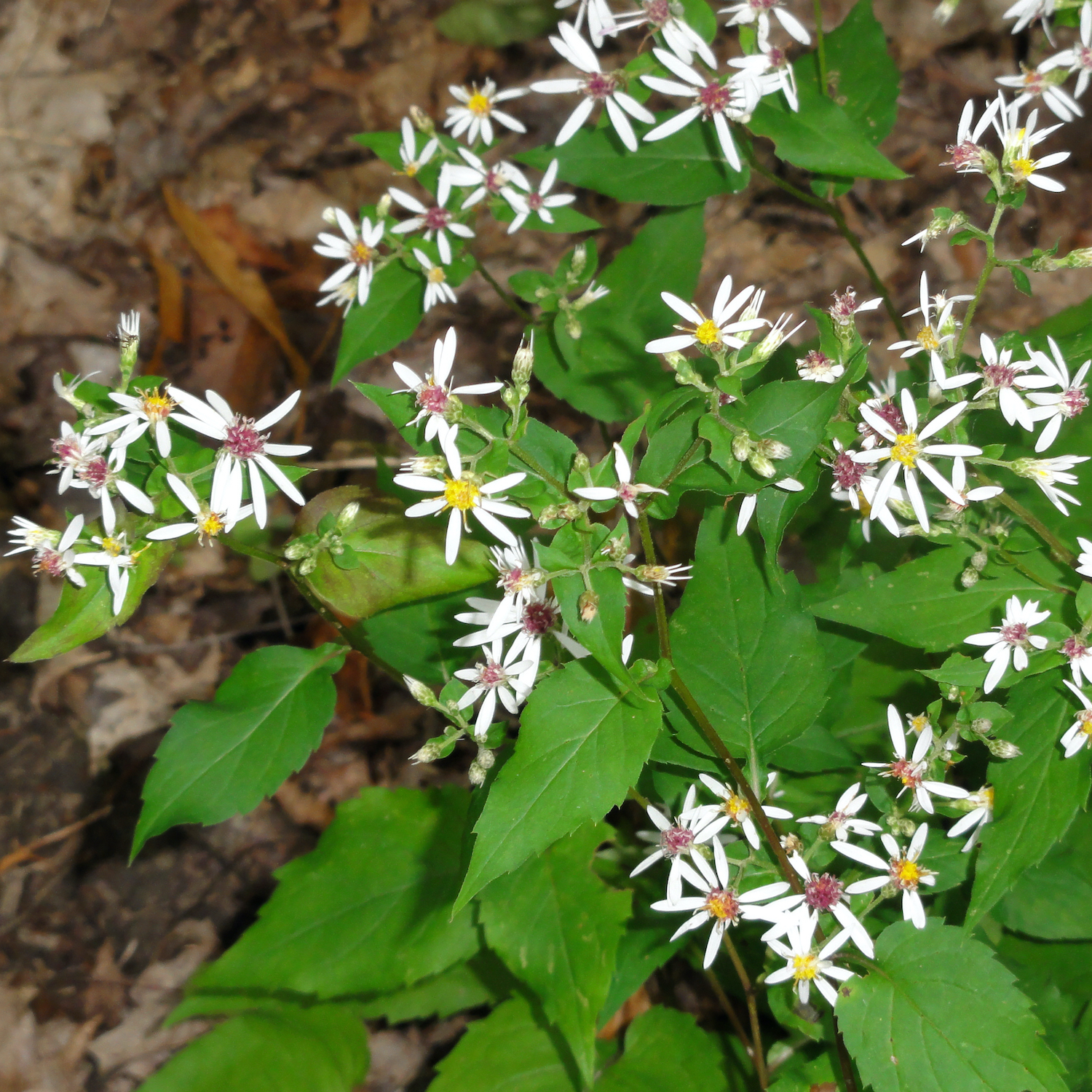
Eurybia divaricata (white wood aster) Lurie Garden
Eurybia divaricata (formerly Aster divaricatus ), commonly known as the white wood aster, is an herbaceous plant native to eastern North America. It occurs in the eastern United States, primarily in the Appalachian mountains, though it is also present in southeastern Canada, but only in about 25 populations in the provinces of Ontario and Quebec.

White Wood Aster Wildflowers Eurybia Divaricata Stock Image Image of america, united 164097601
White wood aster is an eastern species, common throughout New England except confined to the southern portion of Maine. The strongly heart-shaped leaves with large coarse teeth are distinctive. The young leaves are edible when cooked. Habitat Forests Characteristics Habitat terrestrial New England state Connecticut Maine Massachusetts New Hampshire

Eurybia divaricata (White Wood Aster)
Details Seeds/Packet 150 Seeds/Ounce 55,000 Germination Code C (60) ? Life Cycle Perennial Sun Exposure Partial Soil Moisture Medium-Dry Height 2 feet Bloom Time August, September Bloom Color White

White Wood Aster (Eurybia divaricata) Western Carolina Botanical Club
Woodland aster, is a native herbaceous perennial in the Asteraceae (daisy) family. Native to the Eastern United States this wildlfower typically grows in dry open woodlands, primarily in Appalachian mountain areas. Woodland aster can grow to a mounding height of 3 feet and spread vigorously by rhizomes reaching its full growth in 2 to 5 years.

Eurybia divaricata White wood aster3 AH Bowman's Hill Wildflower Preserve
Characteristics Descriptions Light Requirements part-sun, part-shade, shade Soil Moisture dry, moist Soil Description acid, neutral, rich, clay Height 1'-3' Recommended Spacing 12"-16" Bloom Time August, September, October Bloom Color white Hardiness Zone 4, 5, 6, 7, 8 More Filters deer resistant, colonizing, pollinator favorite, shade garden plant

Photo of the entire plant of White Wood Aster (Eurybia divaricata 'Eastern Star') posted by
Eurybia divaricata (syn. Aster divaricatus ), the white wood aster, is an herbaceous plant native to eastern North America. It occurs in the eastern United States, primarily in the Appalachian Mountains, though it is also present in southeastern Canada, but only in about 25 populations in the provinces of Ontario and Quebec.

Aster divaricatus White Wood Aster Keystone Wildflowers
by Lorenzo Cogo. A signature cheese of the Valtellina Valley, Bitto is named after the nearby Bitto River. Bitto is only produced in the summer - when grass appears on the alpine meadows of Valtellina, farmers let their cow's out to feed and use the milk to make Bitto. The cheese is made from cow's milk, but with 10-20% of goat's milk.

White Wood Aster (Eurybia divaricata syn. Aster divaricatus) Monticello Shop
First year plants usually do not bloom. Although all plants grow slowly, their growth rate depends on conditions and is slower in deeper shade or thinner, drier soil. Plants may take 2-5 years to reach their full height. Once established, plants bloom from late summer to early fall, earlier than most asters.

Eurybia divaricata / White Wood Aster Wild Ridge Plants
Eurybia divaricata (White Wood Aster) is an upright, bushy perennial boasting flat-topped clusters of small starry white daisies with pink to yellow centers in late summer and fall. Blooming for weeks, the flowers are quite small, 1 in. across (2.5 cm), but they are produced in such great quantities that they literally cover the plant.

Eurybia divaricata ‘Eastern Star’ White Wood Aster Catskill Native Nursery Plant Shop
Eurybia divaricata can also be found growing along roadsides, woodland edges, and open clearings. White wood aster grows to 2-3 ft tall, spreading by rhizomes or by seed. Numerous white, ray flower petals around a central yellow disk decorate a delicate stem, atop heart-shaped leaves. Blooming September to November.

Asters White woodaster (Eurybia divaricata) Wild Seed Project Shop
Above and Below: The flowers of White Wood Aster are composed of 5 to 10+ white ray florets surrounding a central disc of numerous yellow disc florets that turn reddish at maturity. The rays can also have a lilac tinge of color. They also seem to pointing in various directions. The phyllaries of the flower head (below left) have rounded to pointed in shape and are whitish with dark green tips.

Eurybia divaricata white wood aster Lowlands Nursery Gowanus Canal Conservancy
Eurybia divaricata (white wood aster) is a vigorous North American native that produces small, abundant white flowers that bloom from August to October.. It spreads through rhizomes and can be easily propagated by division. Eurybia divaricata is tolerant of shade, deer, and dry conditions.
Eurybia divaricata white wood aster Herbaceous Perennial/RHS Gardening
White Wood Aster • • • Summary The delicate, airy clouds of white wood aster (Eurybia divaricata) are a must-have for every fall garden. This lovely aster is among the first to bloom in late summer. Small, white, daisy-like flowers with yellow centers that fade to red are borne atop dark green to black stems.

White Wood Aster (Eurybia divaricata) Western Carolina Botanical Club
Eurybia divaricata white wood-aster White wood aster is one of several native flowers that thrive in the dry, acidic shade so typical of New England. Blooming well into fall and yielding fluffy bunches of seeds thereafter, this easy-going species works just as well in all but full-sun.

Eurybia divaricata (White Wood Aster)
The sparkling wines from this small, terroir-driven DOCG wine area in Lombardy, northern Italy, are Italy's answer to Champagne: high-quality, home-grown bubbles of prestige. If these wines are less well known outside Italy it's because the majority of the 20.9 million bottles [ figure for 2021. Source: Franciacorta Consortium] produced in.

White wood aster (Eurybia divaricata, Syn.Aster divaricatus Stock Photo Alamy
White wood asters, Eurybia divaricata, are native perennials in the Asteraceae family, which also includes chrysanthemums, coneflowers, and sunflowers. Photo by Krzysztof Ziarnek, Wikimedia Commons, via CC BY-SA. We link to vendors to help you find relevant products. If you buy from one of our links, we may earn a commission.